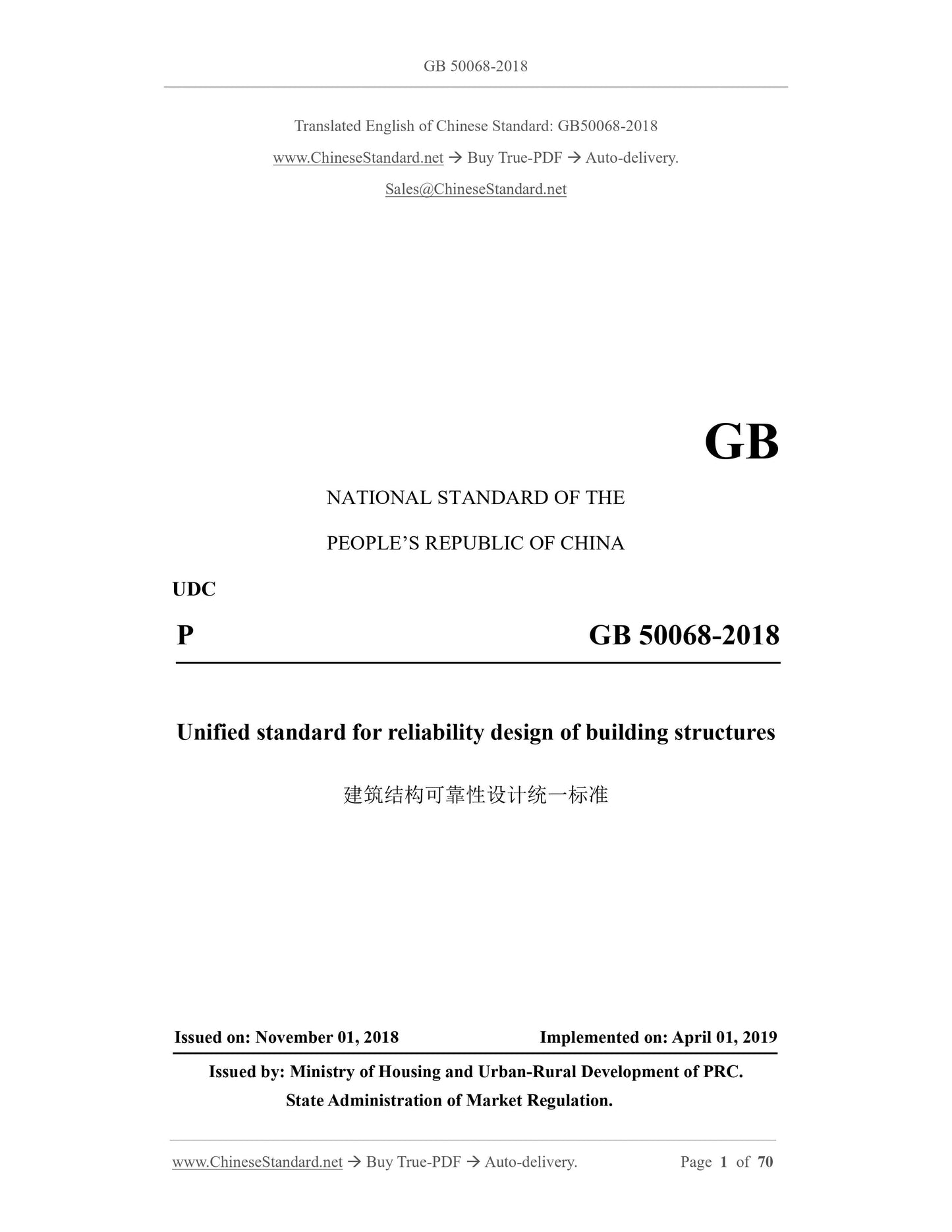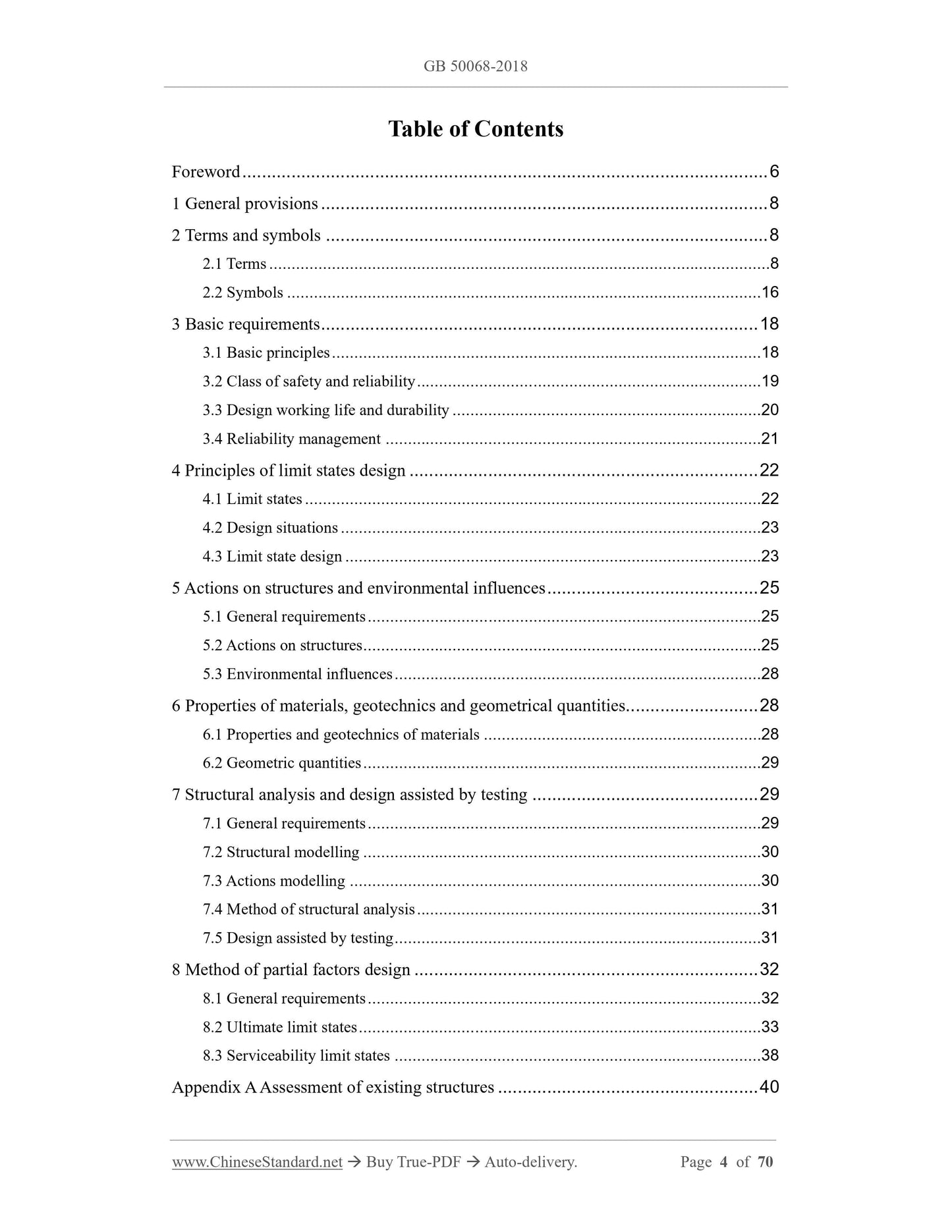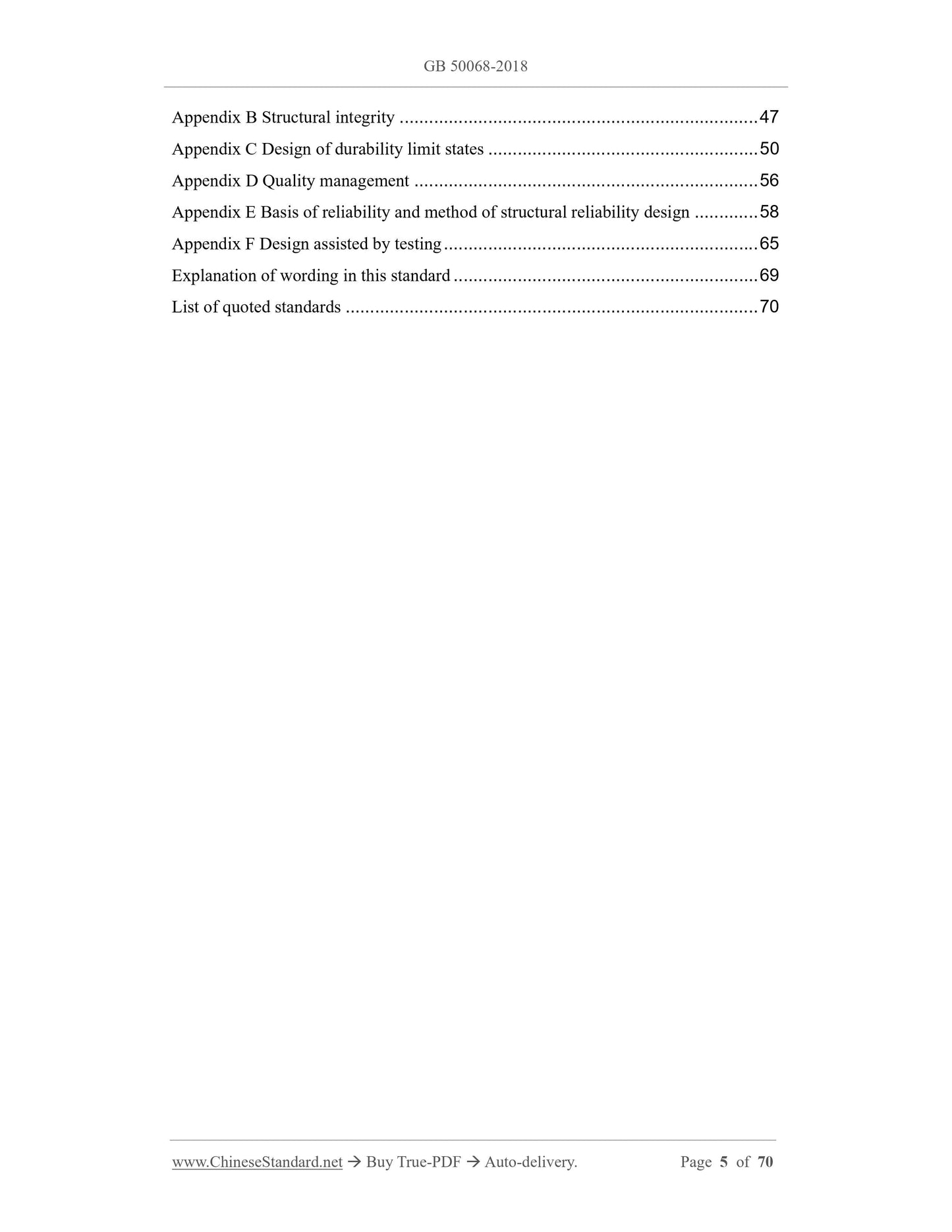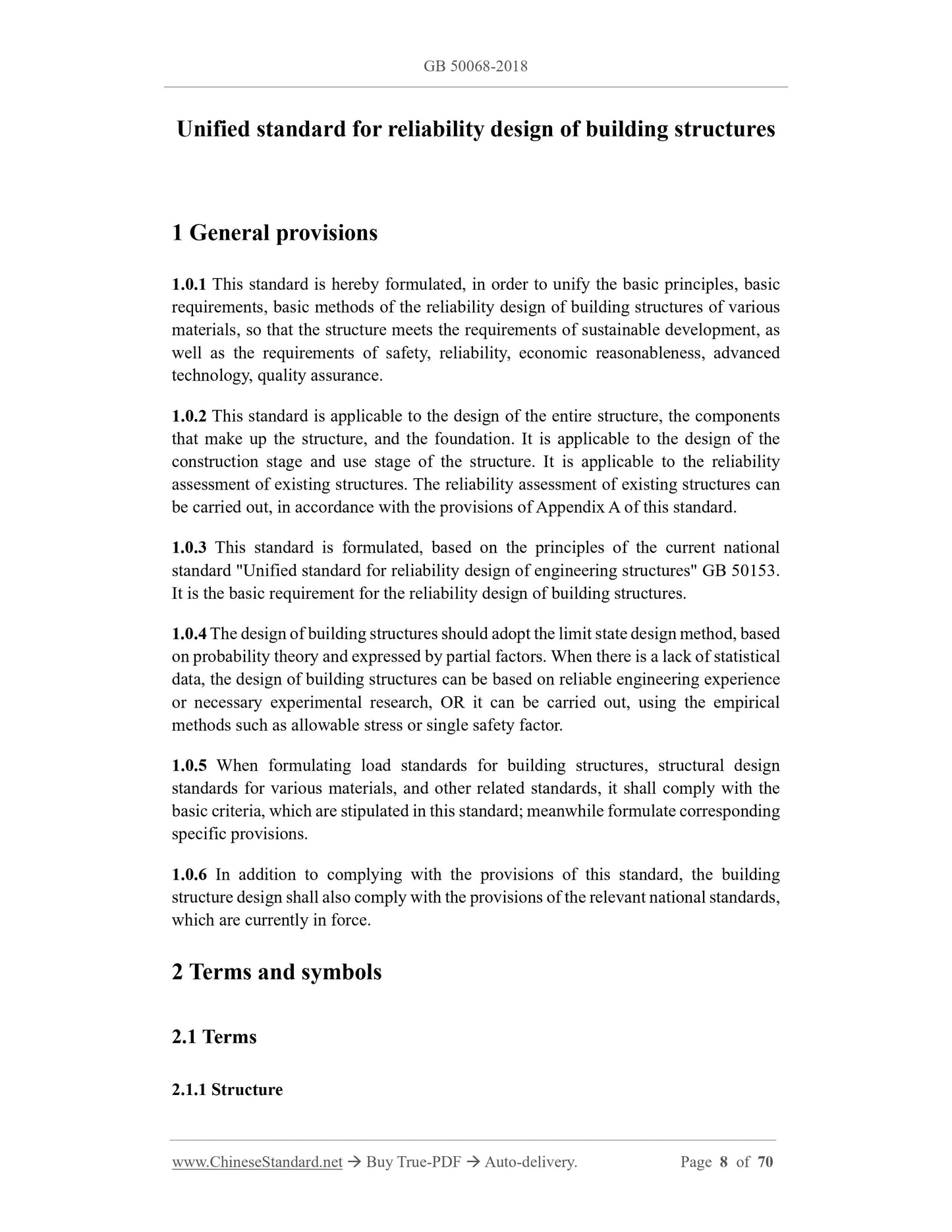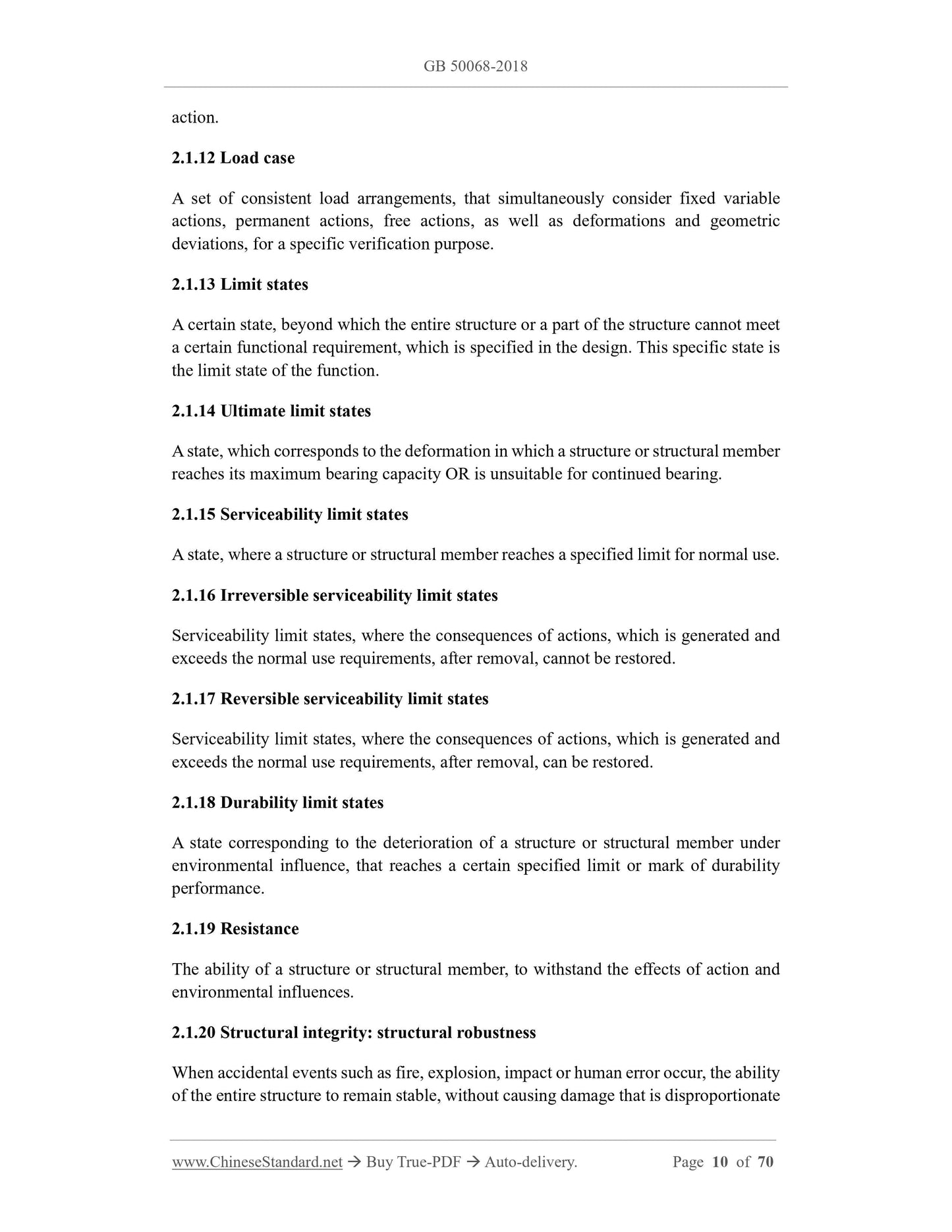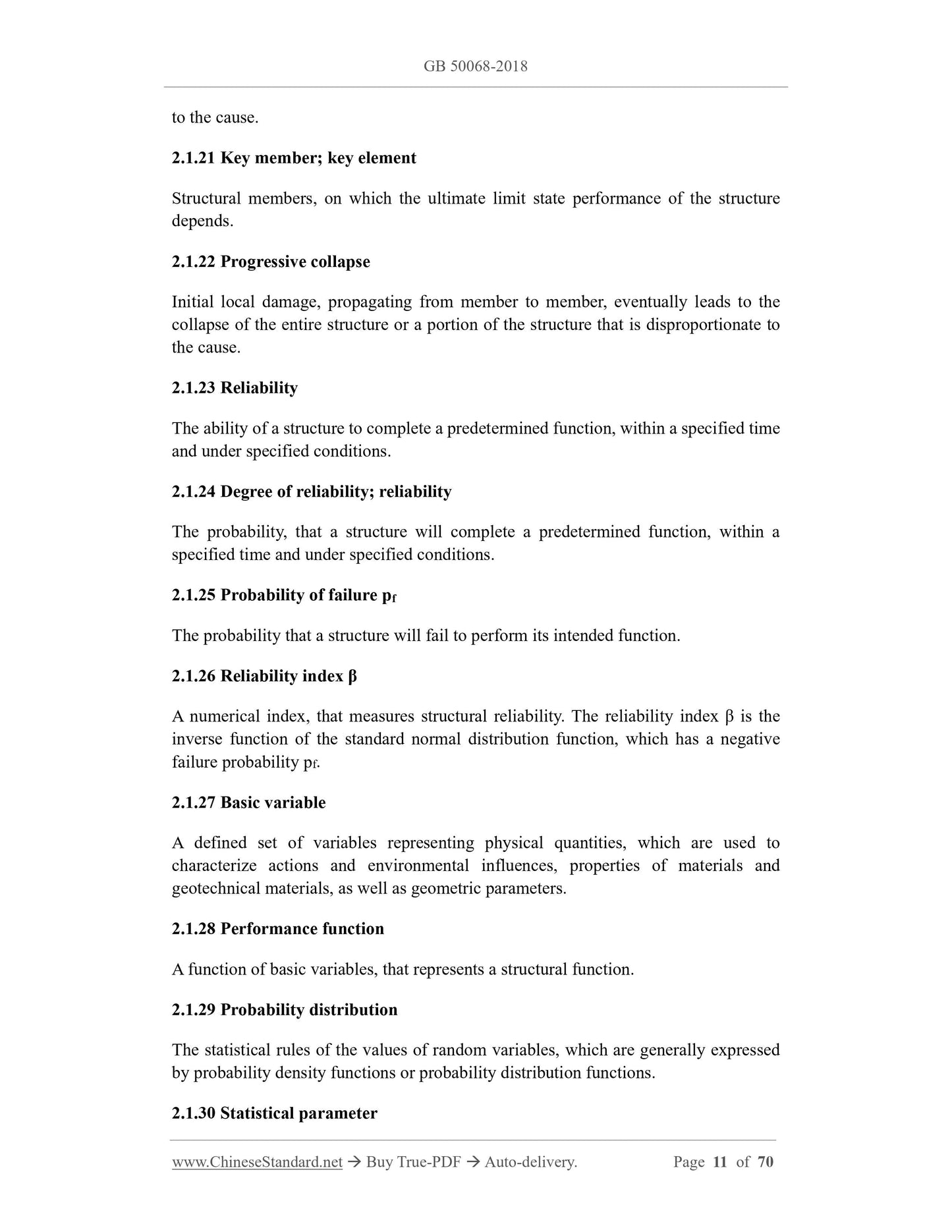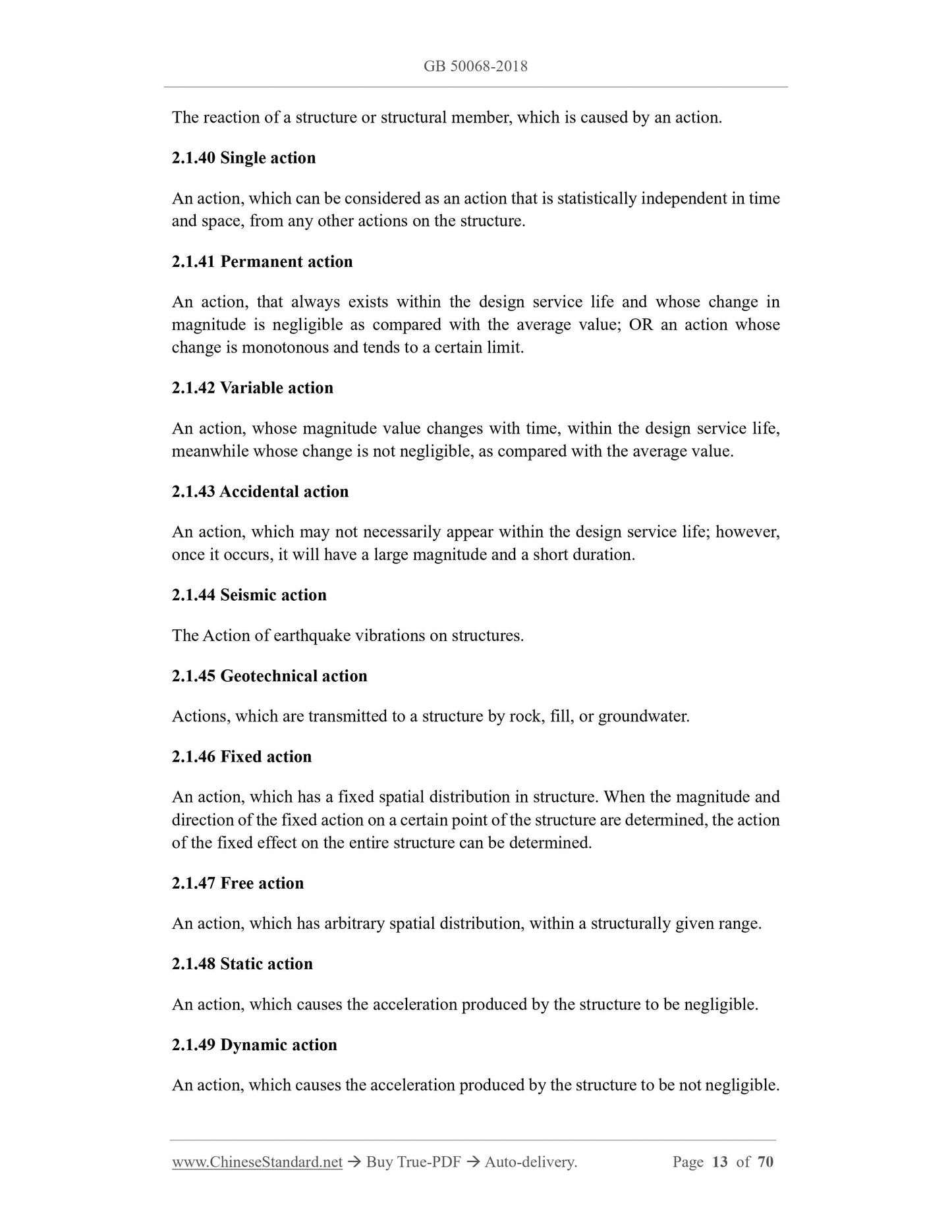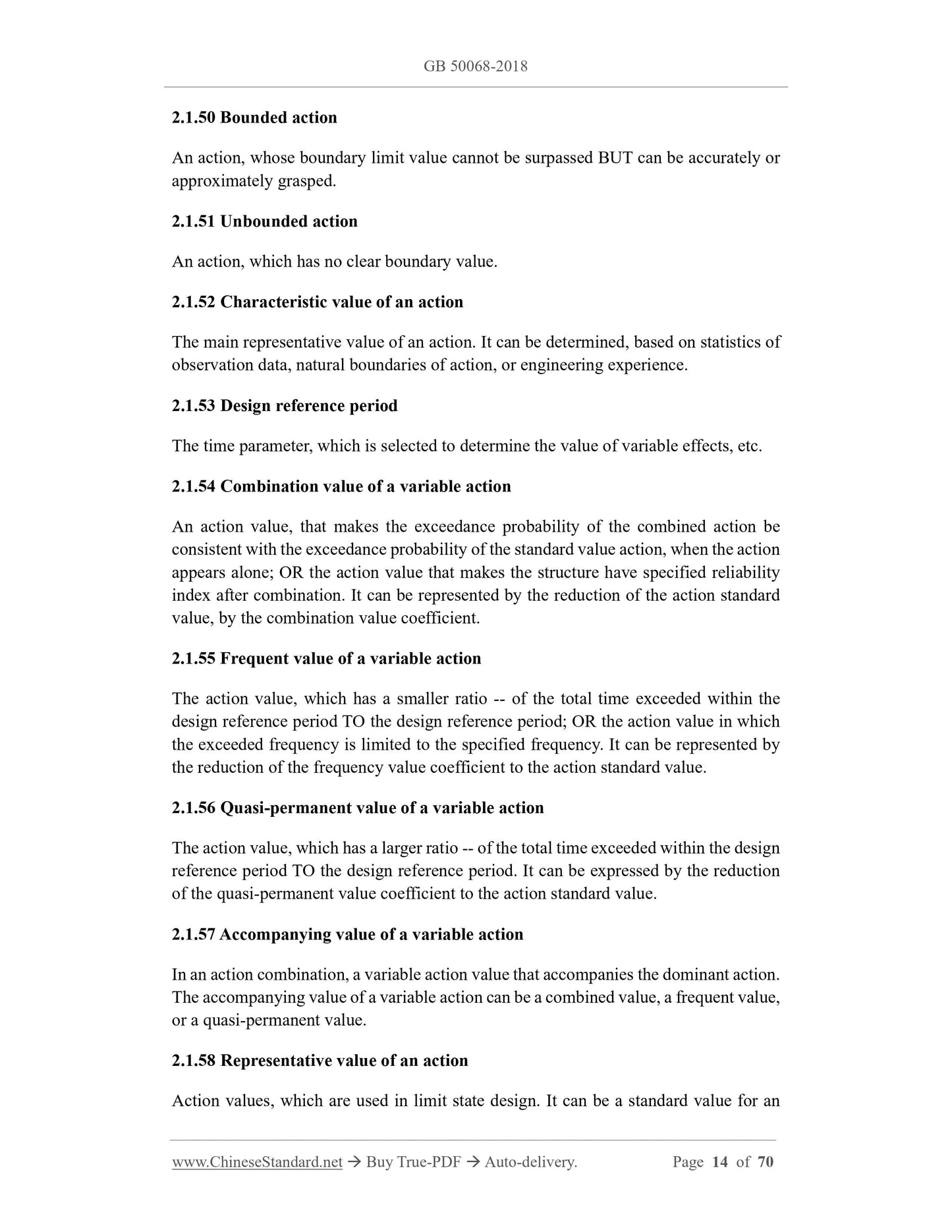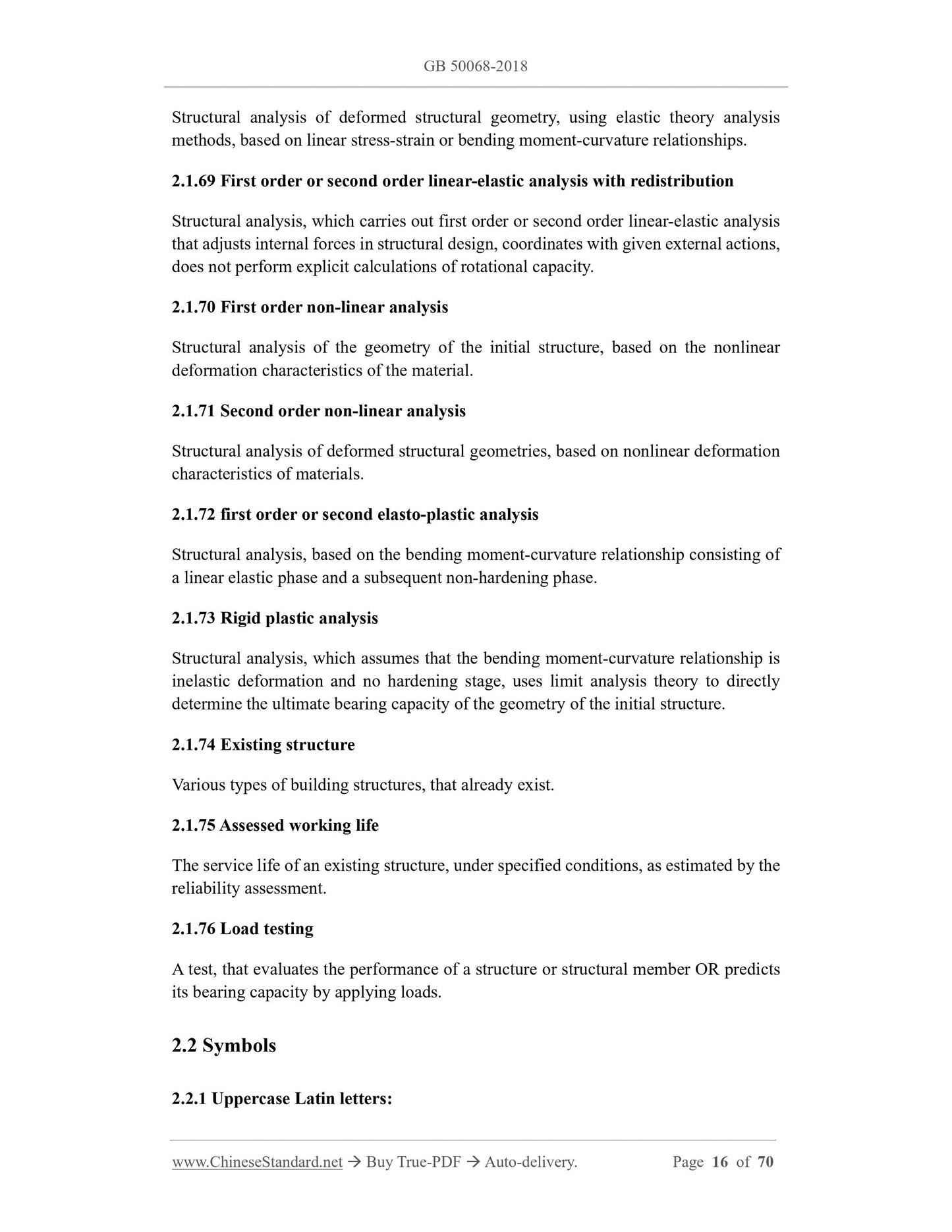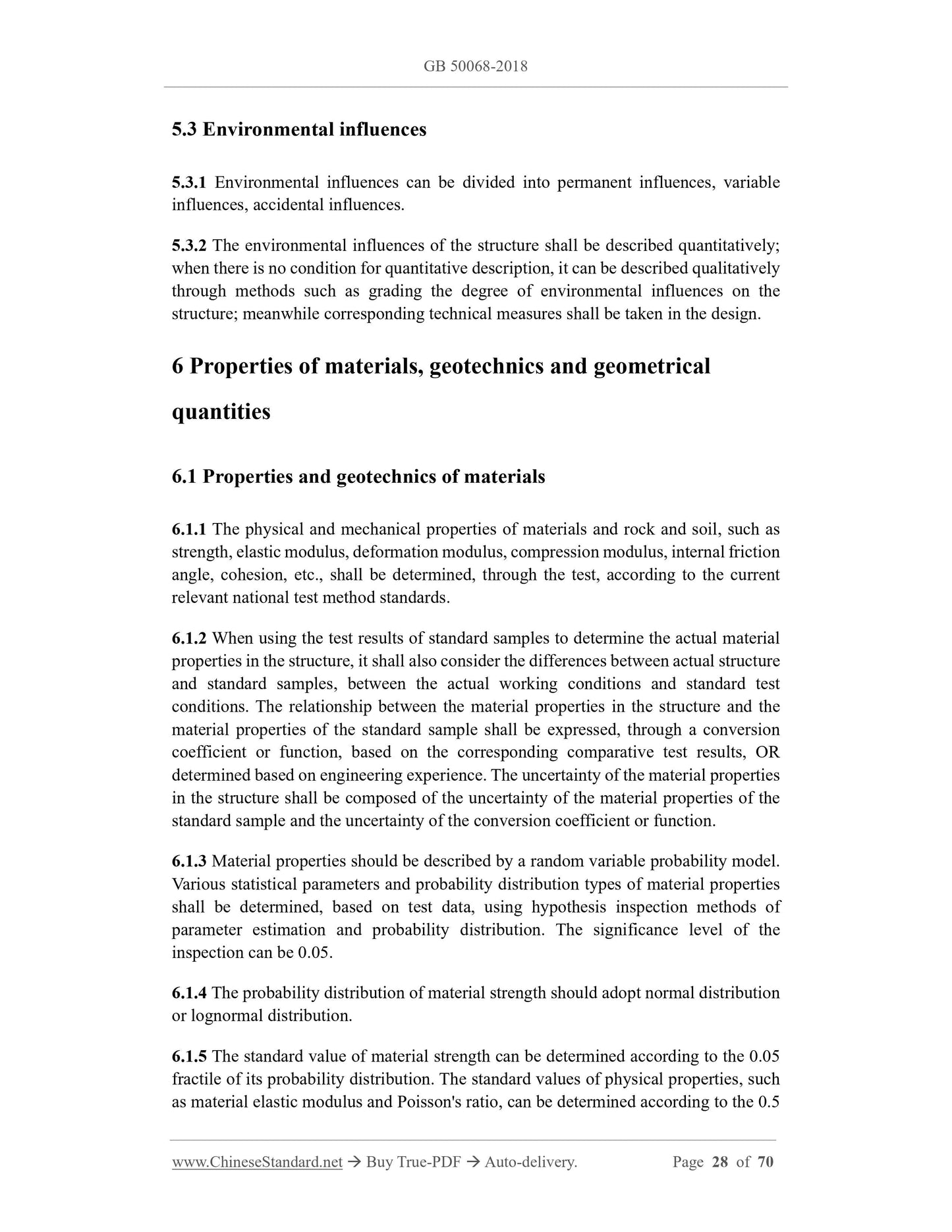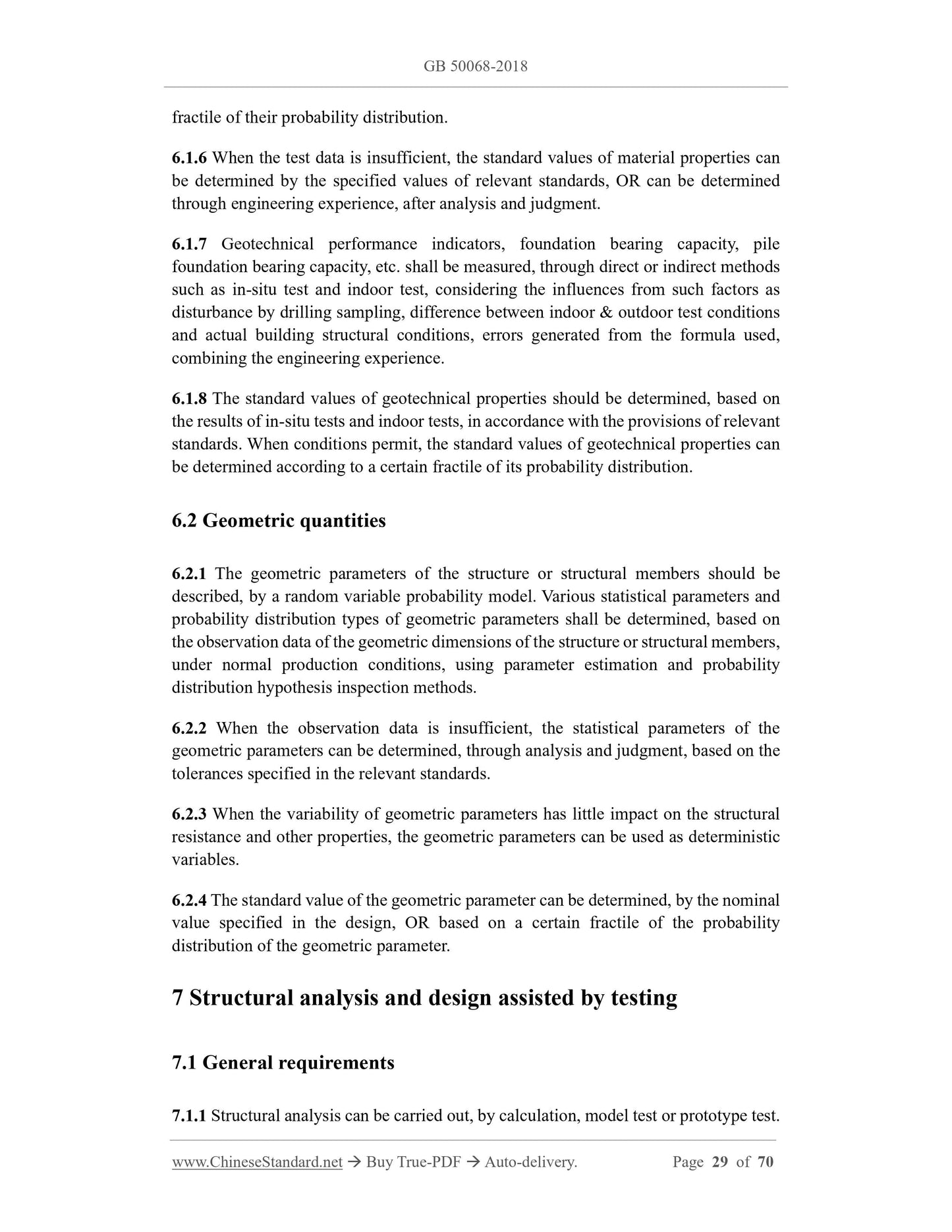1
/
of
12
www.ChineseStandard.us -- Field Test Asia Pte. Ltd.
GB 50068-2018 English PDF
GB 50068-2018 English PDF
Regular price
$685.00
Regular price
Sale price
$685.00
Unit price
/
per
Shipping calculated at checkout.
Couldn't load pickup availability
GB 50068-2018: Unified standard for reliability design of building structures
Delivery: 9 seconds. Download (& Email) true-PDF + Invoice.
Get Quotation: Click GB 50068-2018 (Self-service in 1-minute)
Historical versions (Master-website): GB 50068-2018
Preview True-PDF (Reload/Scroll-down if blank)
GB 50068-2018
GB
NATIONAL STANDARD OF THE
PEOPLE’S REPUBLIC OF CHINA
UDC
P GB 50068-2018
Unified standard for reliability design of building structures
ISSUED ON: NOVEMBER 01, 2018
IMPLEMENTED ON: APRIL 01, 2019
Issued by: Ministry of Housing and Urban-Rural Development of PRC.
State Administration of Market Regulation.
Table of Contents
Foreword ... 6
1 General provisions ... 8
2 Terms and symbols ... 8
2.1 Terms ... 8
2.2 Symbols ... 16
3 Basic requirements ... 18
3.1 Basic principles ... 18
3.2 Class of safety and reliability ... 19
3.3 Design working life and durability ... 20
3.4 Reliability management ... 21
4 Principles of limit states design ... 22
4.1 Limit states ... 22
4.2 Design situations ... 23
4.3 Limit state design ... 23
5 Actions on structures and environmental influences ... 25
5.1 General requirements ... 25
5.2 Actions on structures ... 25
5.3 Environmental influences ... 28
6 Properties of materials, geotechnics and geometrical quantities ... 28
6.1 Properties and geotechnics of materials ... 28
6.2 Geometric quantities ... 29
7 Structural analysis and design assisted by testing ... 29
7.1 General requirements ... 29
7.2 Structural modelling ... 30
7.3 Actions modelling ... 30
7.4 Method of structural analysis ... 31
7.5 Design assisted by testing ... 31
8 Method of partial factors design ... 32
8.1 General requirements ... 32
8.2 Ultimate limit states ... 33
8.3 Serviceability limit states ... 38
Appendix A Assessment of existing structures ... 40
Appendix B Structural integrity ... 47
Appendix C Design of durability limit states ... 50
Appendix D Quality management ... 56
Appendix E Basis of reliability and method of structural reliability design ... 58
Appendix F Design assisted by testing ... 65
Explanation of wording in this standard ... 69
List of quoted standards ... 70
Unified standard for reliability design of building structures
1 General provisions
1.0.1 This standard is hereby formulated, in order to unify the basic principles, basic
requirements, basic methods of the reliability design of building structures of various
materials, so that the structure meets the requirements of sustainable development, as
well as the requirements of safety, reliability, economic reasonableness, advanced
technology, quality assurance.
1.0.2 This standard is applicable to the design of the entire structure, the components
that make up the structure, and the foundation. It is applicable to the design of the
construction stage and use stage of the structure. It is applicable to the reliability
assessment of existing structures. The reliability assessment of existing structures can
be carried out, in accordance with the provisions of Appendix A of this standard.
1.0.3 This standard is formulated, based on the principles of the current national
standard "Unified standard for reliability design of engineering structures" GB 50153.
It is the basic requirement for the reliability design of building structures.
1.0.4 The design of building structures should adopt the limit state design method, based
on probability theory and expressed by partial factors. When there is a lack of statistical
data, the design of building structures can be based on reliable engineering experience
or necessary experimental research, OR it can be carried out, using the empirical
methods such as allowable stress or single safety factor.
1.0.5 When formulating load standards for building structures, structural design
standards for various materials, and other related standards, it shall comply with the
basic criteria, which are stipulated in this standard; meanwhile formulate corresponding
specific provisions.
1.0.6 In addition to complying with the provisions of this standard, the building
structure design shall also comply with the provisions of the relevant national standards,
which are currently in force.
2 Terms and symbols
2.1 Terms
2.1.1 Structure
action.
2.1.12 Load case
A set of consistent load arrangements, that simultaneously consider fixed variable
actions, permanent actions, free actions, as well as deformations and geometric
deviations, for a specific verification purpose.
2.1.13 Limit states
A certain state, beyond which the entire structure or a part of the structure cannot meet
a certain functional requirement, which is specified in the design. This specific state is
the limit state of the function.
2.1.14 Ultimate limit states
A state, which corresponds to the deformation in which a structure or structural member
reaches its maximum bearing capacity OR is unsuitable for continued bearing.
2.1.15 Serviceability limit states
A state, where a structure or structural member reaches a specified limit for normal use.
2.1.16 Irreversible serviceability limit states
Serviceability limit states, where the consequences of actions, which is generated and
exceeds the normal use requirements, after removal, cannot be restored.
2.1.17 Reversible serviceability limit states
Serviceability limit states, where the consequences of actions, which is generated and
exceeds the normal use requirements, after removal, can be restored.
2.1.18 Durability limit states
A state corresponding to the deterioration of a structure or structural member under
environmental influence, that reaches a certain specified limit or mark of durability
performance.
2.1.19 Resistance
The ability of a structure or structural member, to withstand the effects of action and
environmental influences.
2.1.20 Structural integrity: structural robustness
When accidental events such as fire, explosion, impact or human error occur, the ability
of the entire structure to remain stable, without causing damage that is disproportionate
to the cause.
2.1.21 Key member; key element
Structural members, on which the ultimate limit state performance of the structure
depends.
2.1.22 Progressive collapse
Initial local damage, propagating from member to member, eventually leads to the
collapse of the entire structure or a portion of the structure that is disproportionate to
the cause.
2.1.23 Reliability
The ability of a structure to complete a predetermined function, within a specified time
and under specified conditions.
2.1.24 Degree of reliability; reliability
The probability, that a structure will complete a predetermined function, within a
specified time and under specified conditions.
2.1.25 Probability of failure pf
The probability that a structure will fail to perform its intended function.
2.1.26 Reliability index β
A numerical index, that measures structural reliability. The reliability index β is the
inverse function of the standard normal distribution function, which has a negative
failure probability pf.
2.1.27 Basic variable
A defined set of variables representing physical quantities, which are used to
characterize actions and environmental influences, properties of materials and
geotechnical materials, as well as geometric parameters.
2.1.28 Performance function
A function of basic variables, that represents a structural function.
2.1.29 Probability distribution
The statistical rules of the values of random variables, which are generally expressed
by probability density functions or probability distribution functions.
2.1.30 Statistical parameter
The reaction of a structure or structural member, which is caused by an action.
2.1.40 Single action
An action, which can be considered as an action that is statistically independent in time
and space, from any other actions on the structure.
2.1.41 Permanent action
An action, that always exists within the design service life and whose change in
magnitude is negligible as compared with the average value; OR an action whose
change is monotonous and tends to a certain limit.
2.1.42 Variable action
An action, whose magnitude value changes with time, within the design service life,
meanwhile whose change is not negligible, as compared with the average value.
2.1.43 Accidental action
An action, which may not necessarily appear within the design service life; however,
once it occurs, it will have a large magnitude and a short duration.
2.1.44 Seismic action
The Action of earthquake vibrations on structures.
2.1.45 Geotechnical action
Actions, which are transmitted to a structure by rock, fill, or groundwater.
2.1.46 Fixed action
An action, which has a fixed spatial distribution in structure. When the magnitude and
direction of the fixed action on a certain point of the structure are determined, the action
of the fixed effect on the entire structure can be determined.
2.1.47 Free action
An action, which has arbitrary spatial distribution, within a structurally given range.
2.1.48 Static action
An action, which causes the acceleration produced by the structure to be negligible.
2.1.49 Dynamic action
An action, which causes the acceleration produced by the structure to be not negligible.
2.1.50 Bounded action
An action, whose boundary limit value cannot be surpassed BUT can be accurately or
approximately grasped.
2.1.51 Unbounded action
An action, which has no clear boundary value.
2.1.52 Characteristic value of an action
The main representative value of an action. It can be determined, based on statistics of
observation data, natural boundaries of action, or engineering experience.
2.1.53 Design reference period
The time parameter, which is selected to determine the value of variable effects, etc.
2.1.54 Combination value of a variable action
An action value, that makes the exceedance probability of the combined action be
consistent with the exceedance probability of the standard value action, when the action
appears alone; OR the action value that makes the structure have specified reliability
index after combination. It can be represented by the reduction of the action standard
value, by the combination value coefficient.
2.1.55 Frequent value of a variable action
The action value, which has a smaller ratio -- of the total time exceeded within the
design reference period TO the design reference period; OR the action value in which
the exceeded frequency is limited to the specified frequency. It can be represented by
the reduction of the frequency value coefficient to the action standard value.
2.1.56 Quasi-permanent value of a variable action
The action value, which has a larger ratio -- of the total time exceeded within the design
reference period TO the design reference period. It can be expressed by the reduction
of the quasi-permanent value coefficient to the action standard value.
2.1.57 Accompanying value of a variable action
In an action combination, a variable action value that accompanies the dominant action.
The accompanying value of a variable action can be a combined value, a frequent value,
or a quasi-permanent value.
2.1.58 Representative value of an action
Action values, which are used in limit state design. It can be a standard value for an
Structural analysis of deformed structural geometry, using elastic theory analysis
methods, based on linear stress-strain or bending moment-curvature relationships.
2.1.69 First order or second order linear-elastic analysis with redistribution
Structural analysis, which carries out first order or second order linear-elastic analysis
that adjusts internal forces in structural design, coordinates with given external actions,
does not perform explicit calculations of rotational capacity.
2.1.70 First order non-linear analysis
Structural analysis of the geometry of the initial structure, based on the nonlinear
deformation characteristics of the material.
2.1.71 Second order non-linear analysis
Structural analysis of deformed structural geometries, based on nonlinear deformation
characteristics of materials.
2.1.72 first order or second elasto-plastic analysis
Structural analysis, based on the bending moment-curvature relationship consisting of
a linear elastic phase and a subsequent non-hardening phase.
2.1.73 Rigid plastic analysis
Structural analysis, which assumes that the bending moment-curvature relationship is
inelastic deformation and no hardening stage, uses limit analysis theory to directly
determine the ultimate bearing capacity of the geometry of the initial structure.
2.1.74 Existing structure
Various types of building structures, that already exist.
2.1.75 Assessed working life
The service life of an existing structure, under specified conditions, as estimated by the
reliability assessment.
2.1.76 Load testing
A test, that evaluates the performance of a structure or structural member OR predicts
its bearing capacity by applying loads.
2.2 Symbols
2.2.1 Uppercase Latin letters:
3.3.4 The environmental impact shall be assessed, when designing the building
structure. When the environment in which the structure is located has a greater impact
on its durability, it shall take corresponding structural materials, design structures,
protective measures, construction quality requirements, according to different
environmental categories. etc.; formulate a regular inspection and maintenance system,
during the use of the structure, so that the safety or normal use of the structure will not
be affected by material deterioration, within its designed service life.
3.3.5 The impact of the environment on the durability of the structure can be evaluated,
through engineering experience, experimental research, calculation, inspection or
comprehensive analysis. The durability limit state design can be carried out, in
accordance with the provisions of Appendix C of this standard.
3.3.6 The division of environmental categories and the corresponding requirements for
design, construction, use, maintenance shall comply with the relevant national
standards.
3.4 Reliability management
3.4.1 In order to ensure that the building structure has the specified reliability level, in
addition to des...
Delivery: 9 seconds. Download (& Email) true-PDF + Invoice.
Get Quotation: Click GB 50068-2018 (Self-service in 1-minute)
Historical versions (Master-website): GB 50068-2018
Preview True-PDF (Reload/Scroll-down if blank)
GB 50068-2018
GB
NATIONAL STANDARD OF THE
PEOPLE’S REPUBLIC OF CHINA
UDC
P GB 50068-2018
Unified standard for reliability design of building structures
ISSUED ON: NOVEMBER 01, 2018
IMPLEMENTED ON: APRIL 01, 2019
Issued by: Ministry of Housing and Urban-Rural Development of PRC.
State Administration of Market Regulation.
Table of Contents
Foreword ... 6
1 General provisions ... 8
2 Terms and symbols ... 8
2.1 Terms ... 8
2.2 Symbols ... 16
3 Basic requirements ... 18
3.1 Basic principles ... 18
3.2 Class of safety and reliability ... 19
3.3 Design working life and durability ... 20
3.4 Reliability management ... 21
4 Principles of limit states design ... 22
4.1 Limit states ... 22
4.2 Design situations ... 23
4.3 Limit state design ... 23
5 Actions on structures and environmental influences ... 25
5.1 General requirements ... 25
5.2 Actions on structures ... 25
5.3 Environmental influences ... 28
6 Properties of materials, geotechnics and geometrical quantities ... 28
6.1 Properties and geotechnics of materials ... 28
6.2 Geometric quantities ... 29
7 Structural analysis and design assisted by testing ... 29
7.1 General requirements ... 29
7.2 Structural modelling ... 30
7.3 Actions modelling ... 30
7.4 Method of structural analysis ... 31
7.5 Design assisted by testing ... 31
8 Method of partial factors design ... 32
8.1 General requirements ... 32
8.2 Ultimate limit states ... 33
8.3 Serviceability limit states ... 38
Appendix A Assessment of existing structures ... 40
Appendix B Structural integrity ... 47
Appendix C Design of durability limit states ... 50
Appendix D Quality management ... 56
Appendix E Basis of reliability and method of structural reliability design ... 58
Appendix F Design assisted by testing ... 65
Explanation of wording in this standard ... 69
List of quoted standards ... 70
Unified standard for reliability design of building structures
1 General provisions
1.0.1 This standard is hereby formulated, in order to unify the basic principles, basic
requirements, basic methods of the reliability design of building structures of various
materials, so that the structure meets the requirements of sustainable development, as
well as the requirements of safety, reliability, economic reasonableness, advanced
technology, quality assurance.
1.0.2 This standard is applicable to the design of the entire structure, the components
that make up the structure, and the foundation. It is applicable to the design of the
construction stage and use stage of the structure. It is applicable to the reliability
assessment of existing structures. The reliability assessment of existing structures can
be carried out, in accordance with the provisions of Appendix A of this standard.
1.0.3 This standard is formulated, based on the principles of the current national
standard "Unified standard for reliability design of engineering structures" GB 50153.
It is the basic requirement for the reliability design of building structures.
1.0.4 The design of building structures should adopt the limit state design method, based
on probability theory and expressed by partial factors. When there is a lack of statistical
data, the design of building structures can be based on reliable engineering experience
or necessary experimental research, OR it can be carried out, using the empirical
methods such as allowable stress or single safety factor.
1.0.5 When formulating load standards for building structures, structural design
standards for various materials, and other related standards, it shall comply with the
basic criteria, which are stipulated in this standard; meanwhile formulate corresponding
specific provisions.
1.0.6 In addition to complying with the provisions of this standard, the building
structure design shall also comply with the provisions of the relevant national standards,
which are currently in force.
2 Terms and symbols
2.1 Terms
2.1.1 Structure
action.
2.1.12 Load case
A set of consistent load arrangements, that simultaneously consider fixed variable
actions, permanent actions, free actions, as well as deformations and geometric
deviations, for a specific verification purpose.
2.1.13 Limit states
A certain state, beyond which the entire structure or a part of the structure cannot meet
a certain functional requirement, which is specified in the design. This specific state is
the limit state of the function.
2.1.14 Ultimate limit states
A state, which corresponds to the deformation in which a structure or structural member
reaches its maximum bearing capacity OR is unsuitable for continued bearing.
2.1.15 Serviceability limit states
A state, where a structure or structural member reaches a specified limit for normal use.
2.1.16 Irreversible serviceability limit states
Serviceability limit states, where the consequences of actions, which is generated and
exceeds the normal use requirements, after removal, cannot be restored.
2.1.17 Reversible serviceability limit states
Serviceability limit states, where the consequences of actions, which is generated and
exceeds the normal use requirements, after removal, can be restored.
2.1.18 Durability limit states
A state corresponding to the deterioration of a structure or structural member under
environmental influence, that reaches a certain specified limit or mark of durability
performance.
2.1.19 Resistance
The ability of a structure or structural member, to withstand the effects of action and
environmental influences.
2.1.20 Structural integrity: structural robustness
When accidental events such as fire, explosion, impact or human error occur, the ability
of the entire structure to remain stable, without causing damage that is disproportionate
to the cause.
2.1.21 Key member; key element
Structural members, on which the ultimate limit state performance of the structure
depends.
2.1.22 Progressive collapse
Initial local damage, propagating from member to member, eventually leads to the
collapse of the entire structure or a portion of the structure that is disproportionate to
the cause.
2.1.23 Reliability
The ability of a structure to complete a predetermined function, within a specified time
and under specified conditions.
2.1.24 Degree of reliability; reliability
The probability, that a structure will complete a predetermined function, within a
specified time and under specified conditions.
2.1.25 Probability of failure pf
The probability that a structure will fail to perform its intended function.
2.1.26 Reliability index β
A numerical index, that measures structural reliability. The reliability index β is the
inverse function of the standard normal distribution function, which has a negative
failure probability pf.
2.1.27 Basic variable
A defined set of variables representing physical quantities, which are used to
characterize actions and environmental influences, properties of materials and
geotechnical materials, as well as geometric parameters.
2.1.28 Performance function
A function of basic variables, that represents a structural function.
2.1.29 Probability distribution
The statistical rules of the values of random variables, which are generally expressed
by probability density functions or probability distribution functions.
2.1.30 Statistical parameter
The reaction of a structure or structural member, which is caused by an action.
2.1.40 Single action
An action, which can be considered as an action that is statistically independent in time
and space, from any other actions on the structure.
2.1.41 Permanent action
An action, that always exists within the design service life and whose change in
magnitude is negligible as compared with the average value; OR an action whose
change is monotonous and tends to a certain limit.
2.1.42 Variable action
An action, whose magnitude value changes with time, within the design service life,
meanwhile whose change is not negligible, as compared with the average value.
2.1.43 Accidental action
An action, which may not necessarily appear within the design service life; however,
once it occurs, it will have a large magnitude and a short duration.
2.1.44 Seismic action
The Action of earthquake vibrations on structures.
2.1.45 Geotechnical action
Actions, which are transmitted to a structure by rock, fill, or groundwater.
2.1.46 Fixed action
An action, which has a fixed spatial distribution in structure. When the magnitude and
direction of the fixed action on a certain point of the structure are determined, the action
of the fixed effect on the entire structure can be determined.
2.1.47 Free action
An action, which has arbitrary spatial distribution, within a structurally given range.
2.1.48 Static action
An action, which causes the acceleration produced by the structure to be negligible.
2.1.49 Dynamic action
An action, which causes the acceleration produced by the structure to be not negligible.
2.1.50 Bounded action
An action, whose boundary limit value cannot be surpassed BUT can be accurately or
approximately grasped.
2.1.51 Unbounded action
An action, which has no clear boundary value.
2.1.52 Characteristic value of an action
The main representative value of an action. It can be determined, based on statistics of
observation data, natural boundaries of action, or engineering experience.
2.1.53 Design reference period
The time parameter, which is selected to determine the value of variable effects, etc.
2.1.54 Combination value of a variable action
An action value, that makes the exceedance probability of the combined action be
consistent with the exceedance probability of the standard value action, when the action
appears alone; OR the action value that makes the structure have specified reliability
index after combination. It can be represented by the reduction of the action standard
value, by the combination value coefficient.
2.1.55 Frequent value of a variable action
The action value, which has a smaller ratio -- of the total time exceeded within the
design reference period TO the design reference period; OR the action value in which
the exceeded frequency is limited to the specified frequency. It can be represented by
the reduction of the frequency value coefficient to the action standard value.
2.1.56 Quasi-permanent value of a variable action
The action value, which has a larger ratio -- of the total time exceeded within the design
reference period TO the design reference period. It can be expressed by the reduction
of the quasi-permanent value coefficient to the action standard value.
2.1.57 Accompanying value of a variable action
In an action combination, a variable action value that accompanies the dominant action.
The accompanying value of a variable action can be a combined value, a frequent value,
or a quasi-permanent value.
2.1.58 Representative value of an action
Action values, which are used in limit state design. It can be a standard value for an
Structural analysis of deformed structural geometry, using elastic theory analysis
methods, based on linear stress-strain or bending moment-curvature relationships.
2.1.69 First order or second order linear-elastic analysis with redistribution
Structural analysis, which carries out first order or second order linear-elastic analysis
that adjusts internal forces in structural design, coordinates with given external actions,
does not perform explicit calculations of rotational capacity.
2.1.70 First order non-linear analysis
Structural analysis of the geometry of the initial structure, based on the nonlinear
deformation characteristics of the material.
2.1.71 Second order non-linear analysis
Structural analysis of deformed structural geometries, based on nonlinear deformation
characteristics of materials.
2.1.72 first order or second elasto-plastic analysis
Structural analysis, based on the bending moment-curvature relationship consisting of
a linear elastic phase and a subsequent non-hardening phase.
2.1.73 Rigid plastic analysis
Structural analysis, which assumes that the bending moment-curvature relationship is
inelastic deformation and no hardening stage, uses limit analysis theory to directly
determine the ultimate bearing capacity of the geometry of the initial structure.
2.1.74 Existing structure
Various types of building structures, that already exist.
2.1.75 Assessed working life
The service life of an existing structure, under specified conditions, as estimated by the
reliability assessment.
2.1.76 Load testing
A test, that evaluates the performance of a structure or structural member OR predicts
its bearing capacity by applying loads.
2.2 Symbols
2.2.1 Uppercase Latin letters:
3.3.4 The environmental impact shall be assessed, when designing the building
structure. When the environment in which the structure is located has a greater impact
on its durability, it shall take corresponding structural materials, design structures,
protective measures, construction quality requirements, according to different
environmental categories. etc.; formulate a regular inspection and maintenance system,
during the use of the structure, so that the safety or normal use of the structure will not
be affected by material deterioration, within its designed service life.
3.3.5 The impact of the environment on the durability of the structure can be evaluated,
through engineering experience, experimental research, calculation, inspection or
comprehensive analysis. The durability limit state design can be carried out, in
accordance with the provisions of Appendix C of this standard.
3.3.6 The division of environmental categories and the corresponding requirements for
design, construction, use, maintenance shall comply with the relevant national
standards.
3.4 Reliability management
3.4.1 In order to ensure that the building structure has the specified reliability level, in
addition to des...
Share
